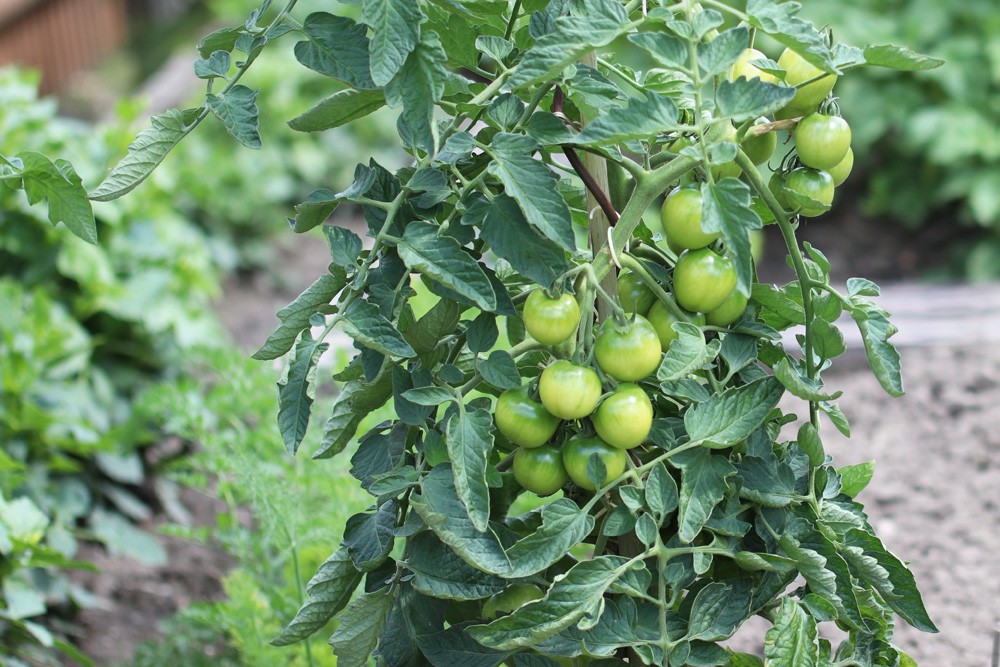Ripe tomatoes not only taste better, but are also healthier than unripe specimens. Because green, unripe tomatoes usually not only have a bitter taste, but can lead to symptoms of poisoning if eaten in large quantities!
Except for some varieties, the green coloration of tomatoes is an indicator of the ripeness of the fruit. As long as the fruits are green in color, they are considered unripe and ideally still remain on the mother plant. This is because at this stage of ripeness, the tomatoes still contain a high amount of solanine, an active ingredient that is toxic to humans and animals. How harmful solanine really is and how you can reduce the solanine content, you can find out here!
Contents
Green tomatoes contain solanine
Before fully ripe tomatoes take on their typical varietal discoloration, they are basically green in color. This is primarily a natural protective mechanism of the plant, as it helps camouflage the green tomatoes. To further protect the fruit, the plant produces the chemical solanine, which is present in all green parts of the plant, including the unripe fruit. Also known as “tomatin”, this substance is toxic and thus protects the plant from animal enemies. However, the solanine content is reduced as ripening progresses, so that fully ripened tomatoes can be eaten without hesitation. However, a small amount of solanine remains in the green parts of the plant such as leaves and stems.
- Solanine is toxic
- it belongs to the group of alkaloids
- many nightshade plants contain solanine
- it is heat resistant and insoluble in fat
- but not carcinogenic
Solanine can have a toxic effect

The consumption of a large amount of solanine can lead to symptoms of poisoning and even death. However, it depends on the amount and the own body weight, because as a guideline: About 1 to 2 milligrams of solanine per kilogram of body weight can already cause symptoms of poisoning. For adults, the consumption of up to 200 milligrams of solanine is generally considered safe, but anything above this level has a toxic effect:
- from 200 mg solanine first symptoms of poisoning
- such as stomach complaints, diarrhea, dizziness
- larger quantities can damage the central nervous system
- this leads to paralysis and cramps
- from 400 mg solanine there is danger to life
Poisoning from green tomatoes unlikely
The solanine content is highest while tomatoes are green and unripe. This is because 100 grams of these fruits contain around 9 to 32 milligrams of solanine. Taking into account the maximum value, the conclusion is therefore that about 625 grams of the green tomatoes can be consumed before the first symptoms of poisoning appear. Life-threatening solanine poisoning from the consumption of green tomatoes is therefore extremely unlikely as a rule. Particularly as the solanine content continues to reduce with advancing ripeness, resulting in the following guide values:
- semi-ripe tomatoes contain about 2mg solanine/100g
- toxic when consumed at around 10 kg
- ripe tomatoes contain about 0.7m solanine/100g
- toxic when consuming about 29 kg
Note: These guideline values refer exclusively to adult humans, children should not consume green tomatoes in principle!
Process green tomatoes

In some regions, the green, unripe tomatoes are considered a specialty and are often made into jams or pickled sweet and sour. The advantage here is that the bitter taste is masked by sugar and other spices. However, this has only a minimal effect on the solanine content! To ensure that no symptoms of poisoning occur, no more than 100 to 150 grams of these specialties should be consumed. The processing of the green, unripe tomatoes has different effects on the solanine content of the fruit:
- pickled tomatoes: about 90% solanine content.
- Tomato jam: Sugar reduces solanine content by about 35%.
- lactic sour: solanine content is reduced by one third
Allow green tomatoes to ripen
Instead of processing the unripe fruits directly, it is worthwhile to let them ripen. It is important to note that only healthy, intact tomatoes are suitable for ripening. Depending on how many green tomatoes are still on the mother plant, various methods are suitable for this. Small quantities can be easily wrapped in newspaper or ripened on the windowsill. For larger quantities, cardboard boxes or baskets are suitable for post-ripening. In order for the fruits to ripen without problems, the following conditions should be met:
- Temperature between 16-25 degrees.
- the warmer it is, the faster the fruits ripen
- relative humidity above 80%
- too humid: fruits rot
- too dry: Fruits dry out
Tip: If there are still many green tomatoes on the mother plant, these should be allowed to ripen on the plant. To do this, pull the plant out of the ground, including the roots, and hang it upside down from the ceiling in a cellar or laundry room.
Green tomato varieties
Although most tomato varieties produce red, yellow or orange fruits, there are still some exceptions: For there are now numerous tomato varieties whose fruits retain their green color even when fully ripe. Among the best-known green tomatoes are the following varieties:
- Green Zebra
- Green Grape
- Kumato
- Lime Green
- Furry Yellow Hog
- Green Bell Pepper
- White Furry Boar
Tip: Whether green tomato varieties are ripe can be determined with a simple pressure test, because the ripe fruits are somewhat softer. Visually, fully ripe green tomatoes can be identified by their size on the one hand and a slight yellow sheen on the other.

